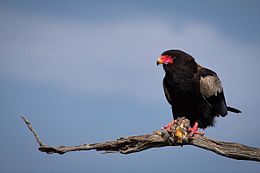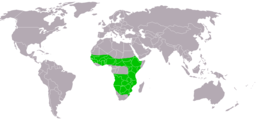Bateleur
| Bateleur | |
|---|---|
 |
|
| Male at Maasai Mara with a coqui francolin kill | |
| Scientific classification | |
| Kingdom: | Animalia |
| Phylum: | Chordata |
| Class: | Aves |
| Order: | Accipitriformes |
| Family: | Accipitridae |
| Subfamily: | Circaetinae |
| Genus: |
Terathopius Lesson, 1830 |
| Species: | T. ecaudatus |
| Binomial name | |
|
Terathopius ecaudatus (Daudin, 1800) |
|
 |
|
| approximate breeding range | |
The bateleur (Terathopius ecaudatus) is a medium-sized eagle in the family Accipitridae. Its closest relatives are the snake eagles. It is the only member of the genus Terathopius and may be the origin of the "Zimbabwe Bird", national emblem of Zimbabwe. It is endemic to Africa and small parts of Arabia. "Bateleur" is French for "Street Performer".
The average adult is 55 to 70 cm (22 to 28 in) long with a 186 cm (6 ft 1 in) wingspan. The wing chord averages approximately 51 cm (20 in). Adult weight is typically 2 to 2.6 kg (4 lb 7 oz to 5 lb 12 oz).
The bateleur is a colourful species with a very short tail (ecaudatus is Latin for tailless) which, together with its white underwing coverts, makes it unmistakable in flight. The tail is so small the bird's legs protrude slightly beyond the tail during flight. The bateleur is sexually dimorphic; both adults have black plumage, a chestnut mantle and tail, grey shoulders, tawny wing coverts, and red facial skin, bill and legs. The female additionally has tawny secondary wing feathers. Less commonly, the mantle may be white. Immature birds are brown with white dappling and have greenish facial skin. It takes them seven or eight years to reach full maturity.
The bateleur is diurnal, and hunts over a territory of approximately 250 square miles (650 km2) a day. Bateleurs are hunters and scavengers; birds such as pigeons and sandgrouse are preferred prey items, although it may attack small mammals and also takes carrion. The bateleur is generally silent, but on occasions it produces a variety of barks and screams. The bird spends a considerable amount of time on the wing, particularly in low-altitude glides. "Bateleur" is French for "street performer" which included performers such as tight-rope walkers. This name implies the bird’s characteristic habit of rocking its wings from side to side when gliding, as if catching its balance.
The bateleur breeds in December–March. It constructs a well-concealed nest in trees, laying a single egg which is incubated by the female for 42 to 43 days, with a further 90 to 125 days until fledging. Bateleurs pair for life, and will use the same nest for a number of years. Unpaired birds, presumably from a previous clutch, will sometimes help at the nest.
...
Wikipedia

